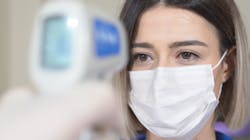Prior to the coronavirus pandemic, practically every human resources professional in the nation would have said that taking an employee’s temperature was risky, ill-advised, and should happen only in very rare circumstances. As with so many things related to COVID-19, something previously thought of as extreme may temporarily be part of our new normal until the virus is no longer considered a threat to public health.
You may already be conducting temperature checks as a result of statewide or local orders, or just because you’ve made it part of your reopening practices to help ensure a safe working environment for everyone. Regardless, it is important to manage this carefully and only as it relates to COVID-19.
What’s changed?
The Equal Employment Opportunity Commission (EEOC) has long considered taking an employee’s temperature to be a “medical examination.” Specifically, they define a medical examination as a “procedure or test that seeks information about an individual’s physical or mental impairments or health.” Further, under the Americans with Disabilities Act (ADA), a medical examination must be job-related and consistent with business necessity to be lawful. Job-relatedness includes concerns about a direct threat to the health and safety of workers and the public.1
According to the EEOC, “based on guidance of the CDC and public health authorities as of March 2020, the COVID-19 pandemic meets the direct threat standard.” In this statement, the EEOC gave the green light to conduct temperature checks on employees for COVID–19-specific reasons.1
Who’s the screener?
While it would be nice to think every employer implementing this screening could have a medical nurse available, that’s not feasible or logical. Therefore, employers must carefully select an internal employee for the role.
These screeners should be trained on how to safely complete temperature screens, the proper use of personal protective equipment (PPE), and maintaining employee privacy. It might be advisable for this training to initially come from a medical professional to ensure it is done properly. It has also been recommended that screeners sign a document establishing the protocol, requiring confidentiality of employee medical information, and confirming that the individual has been informed of and consents to the risks of serving as a screener.
What device is recommended?
To prevent the spread of the virus, employers are advised to use disposable or no-contact thermometers. Without these, inadvertently using a contaminated device is a risk, and may outweigh any potential benefits gained from implementing a screening protocol.
Are employees paid for tempERATURE check-related time?
Simply put, yes, if you make this a requirement of their job, then time spent waiting and receiving a temperature check is paid time.
What about confidentiality?
As a medical exam, any information collected must be treated as a confidential medical record and maintained separately from the employee’s personnel file. Results may be disclosed only in limited circumstances. Employers should consider how to best protect the privacy of any employees who are found to have an elevated temperature and need to be sent home.
Can employees refuse the screening?
If this process is set up properly, then this could be a condition of employment and employees could face consequences if they refuse. Employers should communicate with all employees via written notice or policy that temperature checks will be required. This should be done well in advance of implementing this procedure. Consequences, if administered, must be applied consistently and in a nondiscriminatory manner.
A properly written notification or policy should include, at minimum, the reason for conducting the screening, the method that will be used, the protocol for employees to get screened, how the employer is protecting employee privacy and ensuring safety for all involved, and the consequences for failing to comply.
Once established, the policy must be administered consistently with all employees—any exceptions could result in discrimination claims.
Conclusion
Before conducting a screening of this kind, consider that it is not a completely accurate indicator of the virus. Don’t let temperature screenings provide a false sense of security. If you decide it’s best to implement this, it should be just one part of your new protocols to protect your work environment.
Reference
1. What you should know about COVID-19 and the ADA, the Rehabilitation Act, and other EEO laws. U.S. Equal Employment Opportunity Commission. Updated June 17, 2020. https://www.eeoc.gov/wysk/what-you-should-know-about-covid-19-and-ada-rehabilitation-act-and-other-eeo-laws
Rebecca Boartfield is HR compliance consultant and Tim Twigg is president of Bent Ericksen & Associates. For more than 30 years, the company has been a leading authority in human resources and personnel issues, helping dentists successfully deal with ever-changing and complex labor laws. To receive a complimentary copy of the company’s quarterly newsletter or to learn more, call (800) 679-2760 or visit bentericksen.com.
About the Author

Rebecca Boartfield, SHRM-SCP
Rebecca Boartfield, SHRM-SCP, is an HR compliance consultant for Bent Ericksen & Associates. For more than 40 years, the company has been a leading authority in human resources and personnel issues, helping dentists successfully deal with ever-changing and complex labor laws. To learn more, call (800) 679-2760 or visit bentericksen.com.
